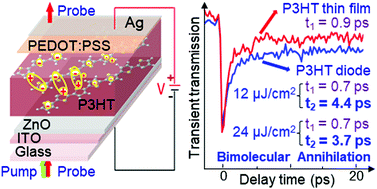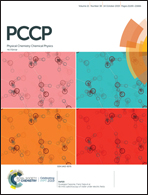Ultrafast polaron-pair dynamics in a poly(3-hexylthiophene-2,5-diyl) device influenced by a static electric field: insights into electric-field-related charge loss†
Abstract
The generation and decay mechanisms of polaron pairs in organic semiconductor-based optoelectronic devices under operational conditions are relevant for a better understanding of photophysical processes affecting the device performance, since the possible occurrence of a polaron pair introduces an intermediate step in exciton dissociation into fully separated charge carriers. The role played by static electric fields in polaron-pair dynamics is important but poorly understood or not investigated in detail. In this work, insights into the polaron-pair dynamics in neat poly(3-hexylthiophene-2,5-diyl) (P3HT) thin films and P3HT films sandwiched between electrical contacts with an applied external static electric field are probed using femtosecond pump–probe transient absorption spectroscopy. Asymmetric contacts result in P3HT devices with application-related diode characteristics. Consistent with the electric field-induced dissociation of oppositely charged species, we show that polaron-pair dissociation into charge carriers occurs in the P3HT device more significantly with increasing reverse bias, and that this process follows an initial instantaneous polaron-pair photoabsorption quenching due to a pronounced immediate loss of primary photoexcitation species (hot excitons). Furthermore, we show that the net-electric field present in the P3HT diode (including built-in-potential at 0 V bias) results in a more complex dynamics with new findings as compared to the neat-P3HT thin film case. Indeed, besides polaron pairs directly originating from hot excitons, we experimentally observe polaron-pair formation during exciton dissociation via a field-mediated generation process, resulting in a slower contribution to the overall decay dynamics. Moreover, unlike in the external electric field-free P3HT film, bimolecular annihilation processes clearly appear as an additional loss channel when a field is applied and hence have an impact on carrier generation performance in a working device.

- This article is part of the themed collection: 2019 PCCP HOT Articles


 Please wait while we load your content...
Please wait while we load your content...